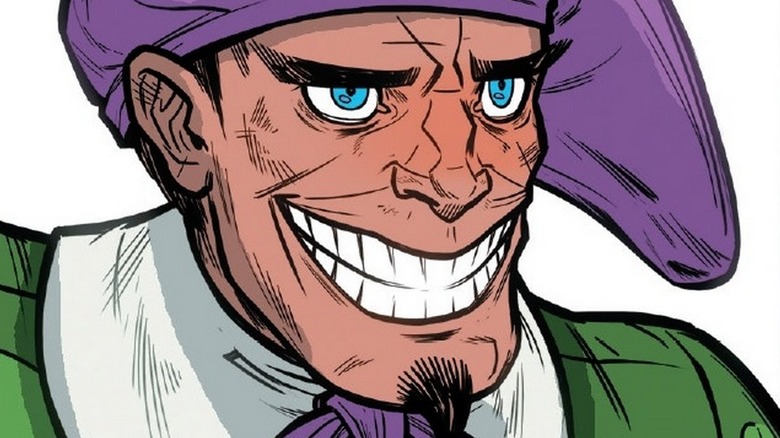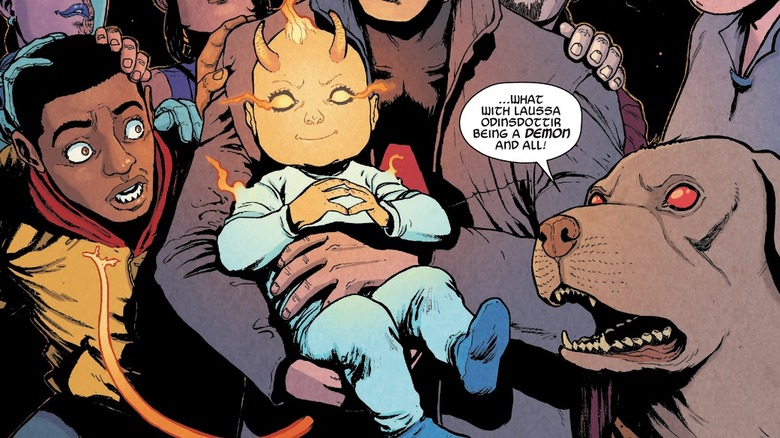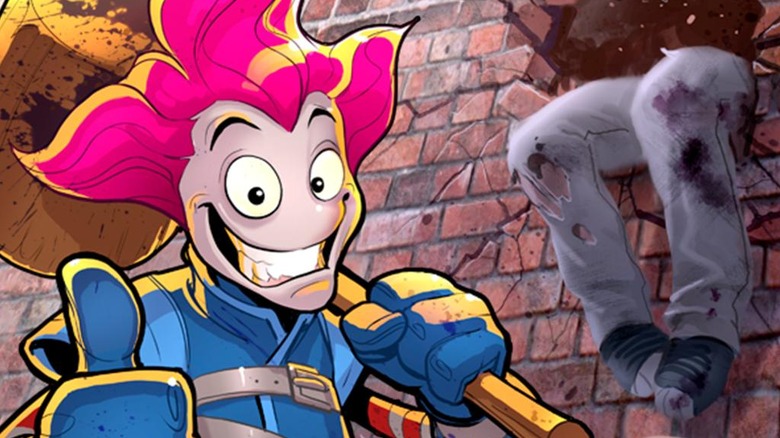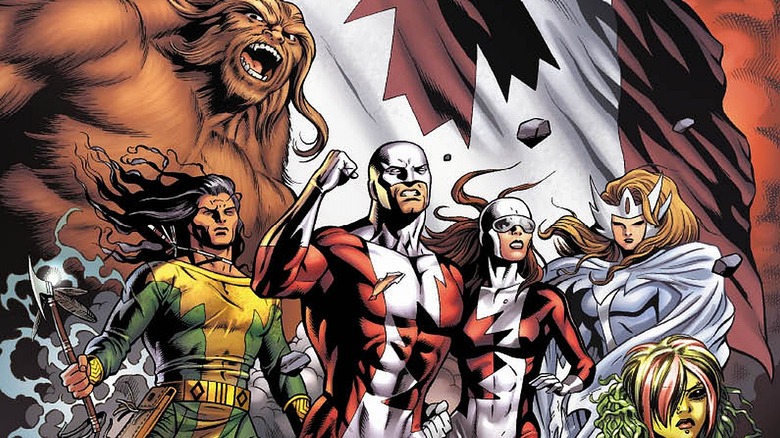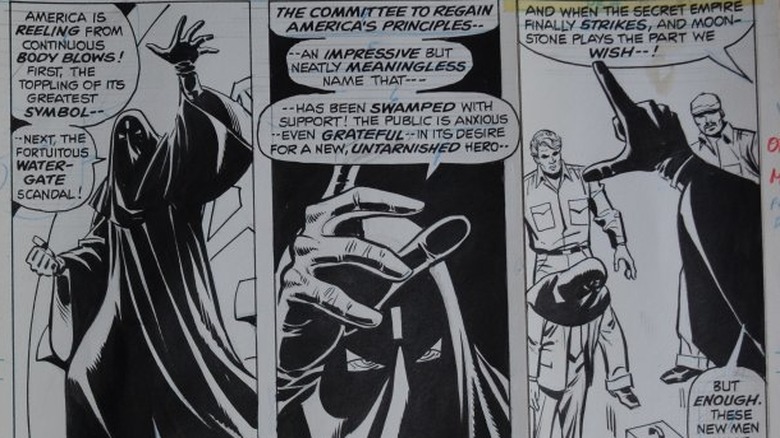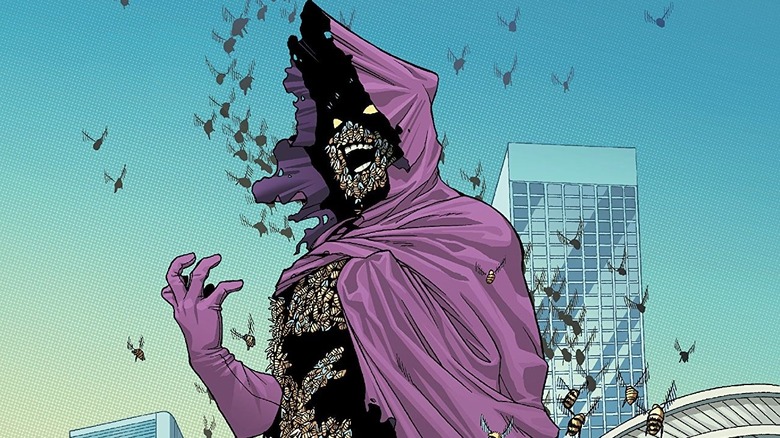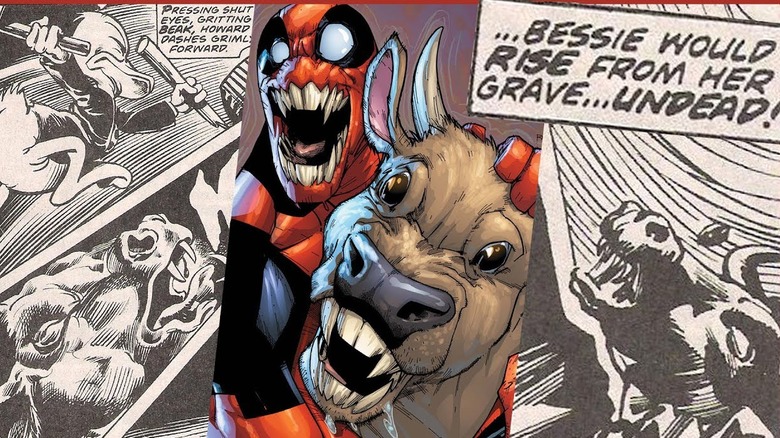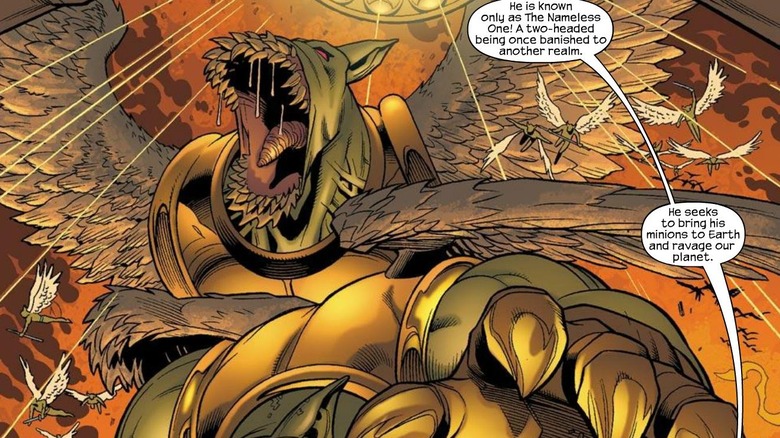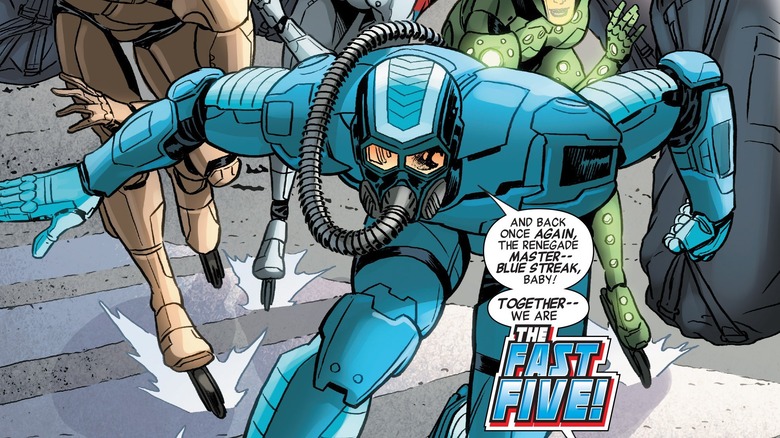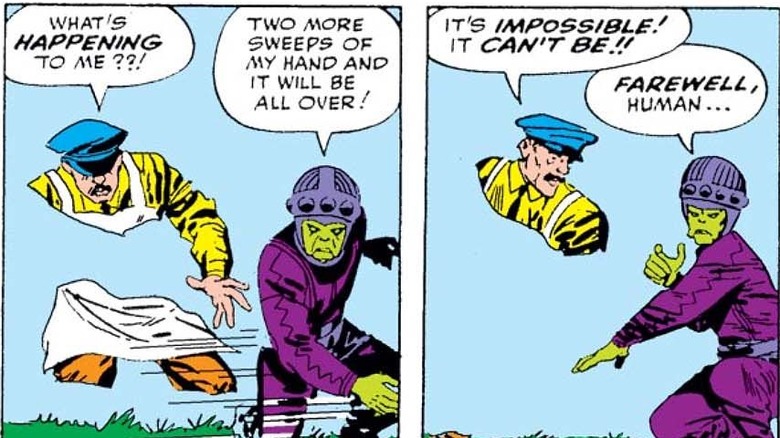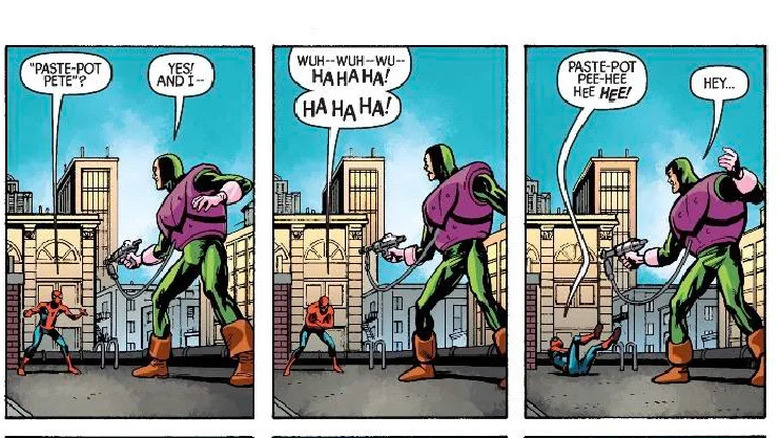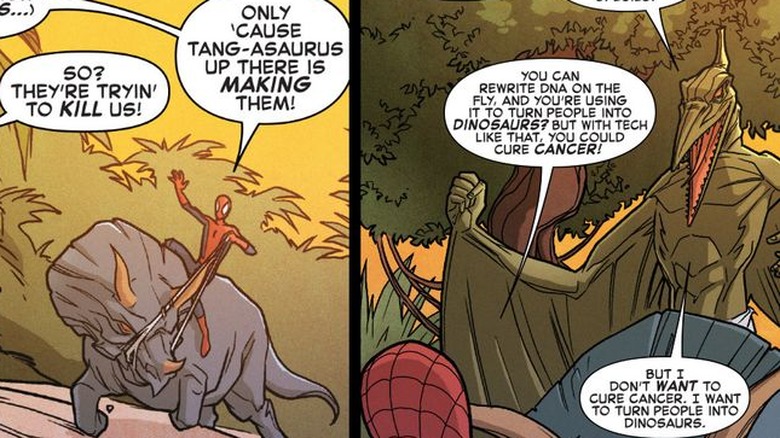The Weirdest Characters That Could Actually Show Up In The MCU
The Marvel Cinematic Universe is going strong, and with that strength it has been increasingly diving head first into the weird: the cosmic, the extra-dimensional, the multiversal, and the bizarre. Who ever expected that some of its more popular characters would be a talking, super-powered tree and a gun-toting raccoon? Not only have the films increasingly opened up to the wide world of Marvel, but with reality-warping characters like Doctor Strange and the Scarlet Witch alongside the commitment to time travel and the multiverse, the sky's the limit for Marvel weirdness.
That said, with a history going back to 1939, Marvel Comics has a vast canon with a substantial bench of heroes and villains — and some of them are undeniably bizarre. Strange in concept or execution, a little outmoded, too surreal, or just a bad fit for the screen, Marvel continuity is beset with odd creations that work for the comics of their eras but seem out of place today. Nonetheless, the MCU has a deep reserve of callbacks and Easter eggs, and room on the roster for oddities. Here are some truly weird Marvel characters that could actually appear in the MCU (played by an Oscar winner, no doubt).
Laussa Odinsdottir
Each of the "Thor" films is notable for expanding the cosmic side of the MCU: "Thor" introduces the basics of Asgard, including the title character, Mjolnir, and Loki, while "Thor: The Dark World" expands our knowledge of the realms further, introducing new cosmic species and a time of primordial universal darkness before our current universe. "Thor: Ragnarok" expands the mythos even more, introducing Odin's firstborn (in the MCU) Hela and filling in a lot of gaps in Asgardian history.
The trick is: Hela was not Odin's only daughter. In the comics, Odin's second daughter was Laussa Odinsdottir (while his first was actually, on the page, Aldrif Odinsdottir). Laussa was conceived when Odin and Freyja were in the realm between realms at a time when the fire demon Surtur was imprisoned there. That resulted in Laussa having THREE parents, with Surtur also being her father. What do you get when an infant is born who is one-third fire demon? A child that spontaneously transforms into a fire demon and consumes things in flame.
Laussa was placed in the furnace powering Heven, the long-cut-off Tenth Realm (long story), which pulled a portion of Surtur's essence from her. She retained some, and remained a hybrid of the demonic and the divine that periodically erupts into flame. While we have no idea what they have in store for us next, the "Thor" series of films has a knack for introducing entire swaths of backstory all of a sudden, so introducing a half-demon fire-child isn't outside the realm of possibilities.
Slapstick
Slapstick began as Steve Harmon of Plainview, New Jersey. He dressed as a clown to blend in at a strange carnival, but had to travel further into the place when two of his peers were kidnapped by evil extra-dimensional jesters. He followed the group into a funhouse, then through a mirror that had become a portal just as it was closing. His molecules stretched across the multiverse before he landed in Dimension X with the Scientist Supreme (who incidentally looks like Groucho Marx). The Scientist Supreme proceeded to train Steve in mastering his new body — his entire being was transformed into "electroplasm," or living unstable molecules, and he had become a living cartoon character. He saved the captured humans, defeated the evil clowns of Dimension X, but was also able to now transform between his human visage and his cartoon-like Slapstick form at will.
Slapstick is a fourth wall-breaking, absurd hero with cartoon physiology. He can manipulate his form in strange ways, and has cartoon-like infinite pockets as well as a subspace pocket in his glove that contains an array of weapons. In short, he's basically a Looney Tunes character in the Marvel Universe, who gets stronger and weirder when hit with electricity. Would Slapstick work in the MCU? Well, Deadpool has covered some of the same meta-territory, and there are already non-MCU, meta-heavy films out there like "Space Jam," "Who Framed Roger Rabbit?" and "Ready Player One," so Slapstick could definitely be in the cards as the MCU experiments with its deep library.
Alpha Flight
There are a number of top shelf superhero teams in the Marvel Universe — the Avengers, Defenders, X-Men, and Fantastic Four among them — but at the same time, there are also some teams who clearly aren't top-shelf ... or are just plain strange. Take Alpha Flight, the team of Canadian heroes that first appeared in "Uncanny X-Men" #120. The team has had its fair share of great heroes — Sasquatch, Guardian, and Northstar are all great characters with interesting powers, and Wolverine himself has been an important on-and-off member of the team. At the same time, a number of its historical members are weak, weird, or outmoded today.
On the one hand, some classic members have odd powers. Stitch (aka Jodi Furman) can manipulate small pieces of metal (sort of like a watered down Magneto). The famous Puck originally was a well-trained, intelligent gymnast with no powers before Master of the World conducted genetic experimentation on his body. Now, Puck's skin is like compressed rubber and he slams into and knocks down enemies sort of like a massive, human bouncy ball. A number of the team's members are also rooted in an indigenous background, but in ways that are stereotypical or oddly conceived. Snowbird, for example, is the daughter of an Inuit goddess ... but she's inexplicably white and blonde. Shaman (Dr. Michael Twoyoungmen) is said to be a doctor and a nature-based magician from the First Nations people, but some have taken issue with his simplistic and borderline stereotypical representation. All the same, Alpha Flight could make its way into the MCU in a modernized form, as it's almost inevitable that Marvel's mutants are on the way as well.
Number One (Secret Empire)
In Marvel history there are a number of hidden nefarious organizations that S.H.I.E.L.D. and groups like the Avengers have warred against. These include supervillain teams like the Masters of Evil and the Sinister Six, as well as notorious political consortiums like the evil HYDRA and Advanced Idea Mechanics (A.I.M.).
One of HYDRA's offshoots is the diabolical organization known as the Secret Empire (which debuted in the MCU as the Council of Nine in the "Agent Carter" series). The Secret Empire has been led by a string of anonymous leaders, always referred to as "Number One" and pursuing the goals of whoever is leading it at a given time (typically, world domination). Their plans have included everything from infiltrating major companies like Roxxon Oil to creating a flying saucer powered by the energy of captured mutants and landing it on the White House lawn.
The weirdest part is who was pulling the strings — the Secret Empire was revealed to be controlled by a very high ranking government official who was attempting a coup. The exact identity isn't revealed, but given that 1) it's implied to be the President, 2) the story was published in 1973 when Nixon was in the Watergate scandal, and 3) the writer intended the issue as a metaphor for the situation and the Nixon era, "Number One" was seemingly meant to be Nixon and the issue saw him kill himself. It's intense, oddly specific, and dark, but all the elements are already set up to include it in the MCU.
Swarm
'Swarm' began its life as the Nazi scientist Fritz von Meyer. Having fled Europe during World War II, he studied bees deep within the jungles of South America. One day he discovered a hive with unusual properties — the bees seemed unusually smart and fearless but strangely passive. He experimented on them to awaken their "killer bee" natures, but he could not control them ... and died. His consciousness dissipated into the swarm of bees and von Meyer became Swarm, a composite being made of numerous bees.
Swarm used its powers to attempt to conquer, its history of villainy involving a variety of bee-based attacks including mechanical bees, creating giant mutated queen bees, giant hives, and other efforts to wage war on humanity. A composite bee-entity would be an odd thing to translate to the screen, but Swarm DOES consider Spider-Man its natural enemy (thinking of spiders and bees as destined foes), so it could make an appearance in a future Spider-Man entry. Anything is possible.
Hellcow
One of the oddest Marvel characters has its roots in the story of the classic vampire Dracula. In the late 1600s, Marvel's iteration of Dracula was hungry as he passed through rural Switzerland, with no easy access to his main food source ... you know, people. In desperation, he attacked a prize cow named Bessie, drinking its blood and leaving it for dead. Bessie's owner Hans buried her the next day, but three nights later the bovine victim rose from the grave to prowl the countryside as an undead cow searching for the source of her new undead status.
Bessie, also known as Hellcow, possesses fangs, immortality, limited shape-shifting ability, and can transform others into vampires through her bite. She also wears a cape that allowed her the power of flight through its transformation into bat-like wings. It's an odd, absurdist character that fits better with the more bizarre heroes and villains of the Marvel Universe like Deadpool and Howard the Duck. Since the character has also been seen in stories with Spider-Man and S.H.I.E.L.D., there are a number of ways she could be incorporated into future MCU movies.
The Nameless One
While "Doctor Strange" started the "weird" phase of the MCU with its commitment to extra-dimensional cosmic horror entities in the form of the dreaded Dormammu (a trend that appears set to continue), there are a number of other frightening entities in Marvel history that are ripe for adaptation. In the comics, the Earth was once ruled by an ancient race of demons known as The Undying Ones who arrived from another dimension. Their ruler is The Nameless One, and long ago their power waned, forcing them to return to their original dimension (with periodic attempts to retake Earth, of course).
Cool concept aside, the visage of the Nameless One is a little ... strange. Not so much a two-headed entity, it rather looks like a winged, clawed, red-eyed beast with an identical, second torso (with a second set of wings) rising out of its back. It isn't two-headed, it's a right and proper, double-torsoed beast ... a visual that would be hard-pressed to not be confusing on screen. Still, this odd entity is a formidable magic user and has a vast army at its command, so perhaps we could see it one day as the MCU continues to embrace the weird.
Blue Streak
Marvel has everything from gods and mutants to cosmic terrors and galactic empires, but it also has ... characters whose powers are a really fast roller derby suit. Don Thomas (aka Blue Streak) was an agent of the criminal organization the Corporation who was sent to infiltrate S.H.I.E.L.D. He became one of their Super-Agents thanks to his high tech roller derby equipment, including skates that go really fast. He was found out as a traitor, imprisoned, but later recruited by Justin Hammer for, well, criminal villainy, using his fast skates and laser weaponry to rob vehicles in the Midwest.
In effect, Blue Streak at his most powerful was a criminal with 125 mph skates, armor, and forearm-mounted lasers that could melt through two inches of steel in 30 seconds (which, by Marvel beam weapon standards is ... fine, we guess). He's a villain with low power and lower ambition. After he died, a man named Jonathan Suit donned his suit to become the new Blue Streak. He organized a group of different-colored fast-skate criminals called the Fast Five, but never really deepened the m.o. or increased the suit's powers. Surely not a major threat, but given the S.H.I.E.L.D. history (and even a history of contention with Falcon), we could imagine a version of the character appearing in future Captain America stories.
The Living Eraser
An early Hank Pym villain, The Living Eraser was an agent of the ruler of Dimension Z. The villain was initially sent to Earth to abduct scientists to build nuclear weapons, and kidnapped a number of Earth's most notable scientists (including Pym, then known as Giant Man). The Wasp freed Pym and the scientists, the plan was foiled, and the heroes returned. The Living Eraser would later stage a coup and take control over Dimension Z, continuing his attempts to steal Earth's nuclear arsenal.
The strangest thing about The Living Eraser is that his weapon, the Dimensionizer, can transport people to other dimensions (mainly between Dimension Z and Earth). The trick, however, is that it doesn't work like, say, a Doctor Strange portal; the weapon passes over a surface, turning it invisible as it does so. The visual effect makes objects look like they're being "erased," and when the entire surface of the being or object is "erased," it's transported to its destination dimension.
The weapon is truly a weird one, and the sight gag clearly works best and makes most sense on a comic panel. How it would translate into the MCU is unclear, but with the character's backstory with Pym and Janet Van Dyne, it could be a fun character to include in future properties that explore the earlier days of MCU heroes.
Paste-Pot Pete
For a supervillain, branding isn't everything ... but it is a lot. You can use your name if it's "cool," sure: Thanos, Loki, Killmonger are all examples. You can use a criminal moniker, like Kingpin, Red Skull, or the parade of Spider-Man villains: Mysterio, Rhino, Scorpion. What you don't want is a villain whose name strikes laughter into the hearts of their enemies, especially if it reminds them of how ridiculous your plans and weapons are. Enter Paste-Pot Pete.
Peter Petruski was a research scientist, patenting a polymer adhesive that brought him wealth and professional success ... so why not turn to crime? He slapped on a ludicrous costume and created a Paste-Gun, engaging in a life of crime under the name Paste-Pot Pete. He frequently tumbled with heroes like Spider-Man and the Human Torch, but frequently found himself the object of ridicule for his goofy name, limited "weapon," and simplistic plans.
The character has since changed his name to the Trapster, a sort of acknowledgment of his earlier failure at branding. An odd villain for sure, but his connection to Spider-Man means he has an easy in to the MCU.
Sauron
Dr. Karl Lykos was a Argentinian hypnotherapist who was attacked by Pteranodons at a young age and immediately repressed it. The bites altered Karl's DNA to some degree, and he discovered he needed to drain life energy to survive. Eventually he met Dr. Charles Xavier, and following a battle between the X-Men and Sentinels, the mutant Havok was put in Karl's care. He siphoned energy from Havok, the first time he'd tried to consume the energy of a mutant, and it triggered his metamorphosis into a humanoid Pteranodon, one who took the name Sauron (after the Tolkien villain).
Sauron eventually became a hopeful conqueror of the Savage Land, a hidden realm where prehistoric creatures roam free, as well as a frequent X-Men foe. He also, somewhat infamously, had an obsession with turning people into dinosaurs. Sauron is a menacing foe, an energy vampire-turned-dinosaur who transforms people into prehistoric creatures. He's awesome, actually. But an energy vampire dinosaur-hybrid that turns people into dinosaurs is also pretty strange; yet with his connections to heroes like Spider-Man and the X-Men, the popular villain may grace the MCU yet ... and honestly it's unlikely they won't visit the Savage Land, so his presence is a near certainty.
